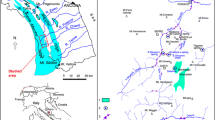Abstract
A dye-tracing test is employed to study the karst development and flow regime at an artesian limestone sub-aquifer, the Khersan3 Dam site, Zagros Zone, Iran. Tracer breakthrough curves showed an early dominant peak followed by a pronounced tailing effect. The peak concentration was a response to induced pressure during dye injection. The results suggest that the dye was pushed into the small pores and fissures around the injection point during dye injection. Hence, the dye moved out as a result of matrix and fissure diffusive processes and created a long pronounced tailing. The maximum flow velocity in the upper artesian sub-aquifer ranged from 0.97 to 2.9 m/h. However, the mean tracer velocity ranged from 0.19 to 0.51 m/h based on the mean residence tracer time; consequently, the flow regime in the artesian sub-aquifer was determined to be mainly diffusive. The results reveal (1) a low hydraulic gradient from upstream of the dam axis to downstream; consequently, there is no considerable flow; (2) poor karst development and diffuse flow at the tracing test area; (3) a discharge zone at a location downstream of the dam axis which is the main terminal of general flow direction at the dam site.







Similar content being viewed by others
References
Alavi M (2004) Regional stratigraphy of the Zagros fold-thrust belt of Iran and its proforeland evaluation. Am J Sci 304:1–20
Bakalowicz M (2005) Karst groundwater: a challenge for new resources. Hydrogeol J 13:148–160
Field MS (1999) Quantitative analysis of tracer breakthrough curves from tracing tests in karst aquifers, In: Palmer AN, Palmer MV, Sasowsky ID (eds) Karst modeling. Special publication 5. Karst Water Institute, West Virginia, pp 163–171
Ford DC, Williams PW (1989) Karst geomorphology and hydrology. Unwin Hyman, London
Hauns M, Jeannin PY, Atteia O (2001) Dispersion, retardation and scale effect in tracer breakthrough curves in karst conduits. J Hydrol 241:177–193
Iqbal MZ (2000) Effects of layered heterogeneity in subsurface geologic materials on solute transport under field conditions: a case study from north-eastern Iowa, USA. Hydrogeol J 8:257–270
James GA, Wynd JG (1965) Stratigraphic nomenclature of Iranian oil consortium agreement area. Bull Am Assoc Petrol Geol 49:2182–2245
Karimi H (2003) Hydrogeological study of aquifers in Khersan3 Dam area using time variations of physico-chemical parameters. Dissertation, MSc. Department of Earth Sciences, Shiraz University, Iran
Mahab Ghodss Consulting Engineers (2000) Engineering geology report on Khersan 3 Dam, Tehran, Iran
Maloszewski P, Benischke R, Harum T, Zojer H (1998) Estimation of solute transport parameters in akarstic aquifer using artificial tracer experiments, chapter 15. In: Dillon P, Simmers I (eds) Shallow groundwater systems. Balkema, Rotterdam, pp 177–190
Massei N, Wang HQ, Field MS, Dupont JP, Bakalowicz M, Rodet J (2006) Interpreting tracer breakthrough tailing in a conduit-dominated karstic aquifer. Hydrogeol J (in press) DOI:10.1007/s10040-006-0093-5
Meus P, Kass W (1992) Tracer tests in small karst systems of the carboniferous limestone in Belgium. In: Hotzl, Werner (eds) Tracer hydrology. Balkema, Rotterdam, pp 271–274
Milanovic PT (1981) Karst hydrogeology. Water Resources Pubs, Fort Collins, Colo.
Mohammadi Z, Raeisi E, Bakalowicz M (2006) Evidence of karst from behavior of the Asmari limestone aquifer at the Khersan3 dam site. Southern Iran. Hydrol Sci J (in press)
Raeisi E, Zare M, Eftekhari P (1999) Application of dye tracing for determining the characteristics of Sheshpeer karst spring, Iran. Theor Appl Karstol 11–12:109–118
Raeisi E, Zare M, Kamali M, Eftekhari P (2001) Hydrogeological behaviour of gypsum formation in Symareh Dam using dye tracer In: Proc New Approaches Characterizing Groundwater Flow. Swets & Zeitlinger Lisse, Germany, pp 1253–1256
Schindel GM, Ray JA, Quinlan JF (1995) Delineation of the recharge area for Rio Springs, Kentucky. In: Proc Karst GeoHazards. Balkama, Rotterdam, pp 165–176
Seiler KP, Behrens H (1992) Groundwater in carbonate rocks of the upper Jurassic in the Frankonian Alb and its susceptibility to contaminants. In: Hotzl, Werner (eds) Tracer hydrology. Balkema, Rotterdam, pp 259–266
Smart CC (1988) Quantitative tracing of the Maligne karst system, Alberta, Canada. J Hydrol 98:185–204
Smart PL, Laidlaw IMS (1977) An evaluation of some fluorescent dyes for water tracing. Water Resour Res 13:15–33
Stevanovic ZP, Dragisic VS (1992) The directions of circulation of karst groundwaters in the Carpatho-Balkanides, Serbia. In: Hotzl, Werner (eds) Tracer hydrology. Balkema, Rotterdam, pp 291–294
Stocklin J (1968) Structural history and tectonics map of Iran: a review. Am Assoc Petrol Geol Bull 52:1229–1258
Stocklin J, Setudehnia A (1977) Stratigraphic lexicon of Iran. Geol Surv Iran, Tehran
Zhengxing M (1988) An outline of the underground water tracing in karst regions of China. In: Proc IAH Congr Karst Hydrol Karst Environ Protection, Guilin, China, pp 894–901
Acknowledgments
The authors thank the Iran Water and Power Resources Development Company (IWPCO) for financial support and the Research Council of Shiraz University for continuous support during this investigation. The authors wish to thank Prof. Philippe Meus (European Water Tracing Services) for comments, which improved original manuscript.
Author information
Authors and Affiliations
Corresponding author
Rights and permissions
About this article
Cite this article
Mohammadi, Z., Raeisi, E. & Zare, M. A dye-tracing test as an aid to studying karst development at an artesian limestone sub-aquifer: Zagros Zone, Iran. Environ Geol 52, 587–594 (2007). https://doi.org/10.1007/s00254-006-0489-5
Received:
Accepted:
Published:
Issue Date:
DOI: https://doi.org/10.1007/s00254-006-0489-5




